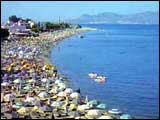|
 Kos
is the third largest island of the Dodecanese and the homeland of Hippocrate,
the father of medicine. A long narrow island with two low mountains, Dikaio and
Simpatro, that run along its southern coast. Its mild climate most of the year,
its large beaches, its energetic nightlife and the enormous historical interest
are some of the factors for attracting tourists every year. Among its landmarks
are the castle of the Knights of St.John, the Asklepeion, the Ancient Agora, the
Archaeological museum, the mosque and the fountain of Gazi Hassan. The cily of
Kos the capital is a modern town, with avenues, modern buildings and hotels
where the plane tree of Hippocrates, under which Hippocrates is said to have
taught. Don’t miss visiting the villages scattered round the island. Among
them are Asfendiou, Pyli, and Andimacheia. Finally Kefalos village and the ruins
of Astypalaia, the birthplace of Hippocrates, are worth a visit. Kos
is the third largest island of the Dodecanese and the homeland of Hippocrate,
the father of medicine. A long narrow island with two low mountains, Dikaio and
Simpatro, that run along its southern coast. Its mild climate most of the year,
its large beaches, its energetic nightlife and the enormous historical interest
are some of the factors for attracting tourists every year. Among its landmarks
are the castle of the Knights of St.John, the Asklepeion, the Ancient Agora, the
Archaeological museum, the mosque and the fountain of Gazi Hassan. The cily of
Kos the capital is a modern town, with avenues, modern buildings and hotels
where the plane tree of Hippocrates, under which Hippocrates is said to have
taught. Don’t miss visiting the villages scattered round the island. Among
them are Asfendiou, Pyli, and Andimacheia. Finally Kefalos village and the ruins
of Astypalaia, the birthplace of Hippocrates, are worth a visit.
Kos town 
 Kos
town is the capital and the main port of the island and is situated on the
northeastern part of it. The town is modern with impressive avenues lined with
palm trees, modern buildings and many archaeological sites. Kos is the ideal
place for walking or bicycling, since bicycles are the favourite means of
transport for the locals. Kos town is the centre of life on the island in every
way. Hotels, tourist facilities, restaurants and a wide variety of shops and
boutiques are concentrated at the capital. Kos
town is the capital and the main port of the island and is situated on the
northeastern part of it. The town is modern with impressive avenues lined with
palm trees, modern buildings and many archaeological sites. Kos is the ideal
place for walking or bicycling, since bicycles are the favourite means of
transport for the locals. Kos town is the centre of life on the island in every
way. Hotels, tourist facilities, restaurants and a wide variety of shops and
boutiques are concentrated at the capital.
Villages 
Asfendiou: One of the most attractive villages, located on the slopes of
mountain Dikaion overlooking the sea, including the villages Zia, Lagoudi,
Asomatos, Agios Dimitrios and Evangelistria. Pyli: A village surrounded
by green fields, where a ruined Byzantine fortress shelters a church dedicated
to the Virgin within its walls. Antimachia: Is built on a plateau near
the island’s airport. Visit the Venetian castle that dominates from the hill
as well as the two well preserved Byzantine churches enclosed within it. Kefalos:
A distant village, 43km from the city of Kos, located on a hill with traditional
white houses.
The Asklepieion 
 The Asklepieion was discovered in 1902 by the German archaeologist Herzog, it
was built after the death of Hippocrates, in the mid 4th c B.C. and it is
located 4 kilometres from the capital of the island on the top of a hill. The
Asklepieion, were methods of Asclepius were applied for the treatment of the
ill, was so famous at its times that many medicine students and patients from
all over the world used to visit it.
The Asklepieion was discovered in 1902 by the German archaeologist Herzog, it
was built after the death of Hippocrates, in the mid 4th c B.C. and it is
located 4 kilometres from the capital of the island on the top of a hill. The
Asklepieion, were methods of Asclepius were applied for the treatment of the
ill, was so famous at its times that many medicine students and patients from
all over the world used to visit it.
Archaeological Museum

The archaeological museum contains findings from the Classical, Hellenistic and
Roman eras including ancient ceramics, small statues of Aphrodite and Eros,
intricate mosaics and the 4th c. BC statue of Hippocrates.
Beaches 
 Kardamena:
A long beach of white sand and crystal clear waters, that starts from the
village’s port and continues for more than three kilometres. Kardamena is the
second largest tourist resort. Lambi: Located in Kos town. It is a one
kilometre sandy, organized beach with a number of restaurants, snack bars and
coffee shops. Therma: Hot Springs ending up into the sea through the
black sand, warm the waters up, for early of late season swims. The temperature
of the water can sometimes reach 40 degrees Celsius - approximately 110 degrees
Fahrenheit Kardamena:
A long beach of white sand and crystal clear waters, that starts from the
village’s port and continues for more than three kilometres. Kardamena is the
second largest tourist resort. Lambi: Located in Kos town. It is a one
kilometre sandy, organized beach with a number of restaurants, snack bars and
coffee shops. Therma: Hot Springs ending up into the sea through the
black sand, warm the waters up, for early of late season swims. The temperature
of the water can sometimes reach 40 degrees Celsius - approximately 110 degrees
Fahrenheit
How to get there 
By air: from the Eleutherios Venizelos airport of
Athens By ferry: from Piraeus
|